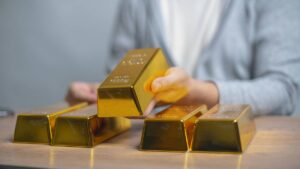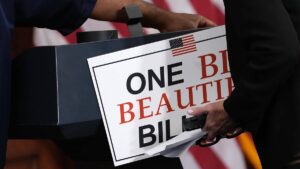Monsters of Rock: St Barbara shareholders vote up Genesis bid in Leonora ménage à trois

Pic: Grinvalds/iStock via Getty Images
- St Barbara shareholders approve sale of Gwalia gold mine and Leonora assets to Genesis Minerals ahead of acquirer’s vote this arvo
- BCI reports cost blowout at Mardie Salt
- Regis tunes up underground strategy in resource and reserve update
St Barbara (ASX:SBM) shareholders have voted to swiftly move on from a torrid recent history at the Gwalia gold mine, voting to sell the historic project to Raleigh Finlayson’s Genesis Minerals (ASX:GMD) despite interest from a larger suitor in Silver Lake Resources (ASX:SLR).
St Barbs routinely refused to engage with Silver Lake, which made a string of attempts to muscle in on the action over the past year.
Most recently it tabled a number of non-binding indicative proposals the SBM board ignored in favour of the agreed transaction with Genesis.
A range of excuses were delivered despite the SLR bid coming in at a higher nominal value than the Genesis offers, which finished with a combination of $370 million cash, 152,826,087 shares and 52,173,913 performance rights to be vested if the transaction is approved before June 30.
SBM said SLR’s proposed premium over the Genesis offer was counteracted by the break fee payable to Genesis and increased time to complete the bid. That could have seen it violate debt covenants with its financiers, SBM had argued.
SLR’s final bid came in at $370m in cash and 327.1m Silver Lake shares valued at $348m as of the timing of its last bid on May 31.
Since that date GMD stock has risen 10.5%, while Silver Lake’s has been stagnant, lifting just 1c.
Rejection by SBM’s board had tapped the support of major shareholders L1 Capital and Baker Street Capital Managers to force SBM to engage.
But only an affirmative vote on the deal by Genesis shareholders needs to happen to give the sale the tick of approval, with almost 78% of SBM’s shareholders’ votes in favour of the transaction. Only a simple majority was needed to give the thumbs up.
What is Genesis getting?
Genesis was due to hold its vote at 2pm today, and has previously stated it has the support of its top 20 shareholders, representing 49% of the shares on issue.
SBM’s parlous financial state prompted a rethink on an earlier deal to merge the two companies and hive off two unloved assets – the Simberi mine in PNG and Atlantic Gold Operations in Canada – into a separate entity called Phoenician Metals.
Gwalia would have been funnelled into a business called Hoover House, paying tribute to the 31st US President Herbert Hoover, who ran the mine as a young engineer when it opened in the late 1890s, as well as the Bed and Breakfast and former mine manager’s cottage that overlooks the open pit.
Alongside it would be Genesis’ high grade Ulysses underground and Dacian Gold’s (ASX:DCN) Mt Morgans mine and processing plant, which Genesis holds a more than 80% in through a takeover partially completed last year.
The buzzword is regional consolidation, something Silver Lake certainly wouldn’t have offered. While it is, unlike Genesis, an active gold producer selling over 250,000ozpa, none of its operations – Deflector in the Mid West, Mt Monger near Kalgoorlie and Sugar Zone in Canada – offer obvious geographical synergies with Gwalia.
But Gwalia, one of Australia’s cheapest, highest grade and biggest gold mines only five years ago, has seen better days.
It delivered just 30,942oz at $2809/oz and a mined grade of 4.6g/t in the March quarter. Once a more than 300,000ozpa producer, St Barbara’s Leonora project is expected to turn out just 130,000-135,000oz this financial year at AISC of $2650-2750/oz.
After delivering operating cash flows of $177 million in FY22, it has contributed just $16m across the first nine months of FY23.
The question will be whether Raleigh Finlayson, who turned small cap Saracen Mineral Holdings into one of Australia’s largest gold companies before its $16 billion merger with Super Pit co-owned Northern Star Resources (ASX:NST), can galvanise the troops and find yet another life for the mine once run by his uncles Chris and Peter Lalor at Sons of Gwalia.
Genesis (ASX:GMD), St Barbara (ASX:SBM) and share price today:
Cost overruns for BCI
BCI Minerals (ASX:BCI) revealed today its Mardie salt project, the first major salt development in 25 years in WA’s North West, will come in at a cost of $1.63 billion including a $208 million contingency.
That compares to just $1.05b, including a $110m reserve at the time of an FID last year for the project, funded in part by low-cost loans from the Feds.
It will not see salt hit a ship until mid-2026 ahead of its ramp up to 5.35Mtpa with sulphate of potash production, expected to hit 140,000tpa once fully ramped up, now not expected until the second half of 2027.
However, BCI says the projects will be more profitable once it is in operation, projecting an increase in long run salt and potash prices from US$49.6/t to US$64.8/t and US$573/t to US$708/t respectively against FID numbers.
That could drive a 50% increase in annual EBITDA to $384m.
It comes after project delays and an 18-month-long review for the Kerry Stokes-backed miner, which parted ways with its previous MD Alwyn Vorster last year and now has former Bravus CEO and BHP coal GM David Boshoff at the helm.
Regis sharpens underground tools in face of higher cost environment
Regis Resources (ASX:RRL) has carved over 2Moz out of its resource base and over 500,000oz from reserves in a tactical shift to focus on an underground future at its Duketon and part-owned Tropicana gold mines.
Despite outpacing depletion in its underground resources and reserves, Regis’ restarted resources have fallen from 9.92Moz last year to 7.02Moz this year, with reserves down from 4.14Moz to 3.6Moz.
But the gold miner, which expects to produce 450,000-500,000ozpa over the next eight years from its current reserve base, is planning to focus increasingly on underground operations, which are more shielded than open-pit mines from cost increases seen across the industry.
An exploration target has been established also for the Garden Well underground, which could become a new production front at Duketon, with a potential Havana underground shaping as one of three alongside Tropicana and Boston Shaker at the Tropicana JV with AngloGold Ashanti.
“We are extremely pleased that our underground mines at both Duketon and Tropicana have outpaced depletion for the second year in a row. We have spent the last 2 years investing in these mines and it is very satisfying to deliver Reserve growth on these investments over this short time horizon,” Regis MD Jim Beyer said.
“It is still early days in the maturity of these undergrounds and we look forward to the continuing growth potential as we mine deeper.
“Our long Reserve life of eight years and located wholly within Australia provides a strong platform to deliver on our long-term growth objectives and achieve superior returns for our shareholders.”
RBC’s Alex Barkley said Regis, on which the investment bank has an outperform rating and $2.60 price target, was shifting to better ore sources.
“The underground designs have more robust economic margins and a higher probability of conversion to Reserves. Higher costs are being seen industry-wide, and RRL was in the fortunate position of having enough gold to shift focus to better sources,” he said in a note to clients.
“This Resource excludes a maiden, low-confidence, Exploration Target at Garden Well Main Underground of 0.8-1.3Moz.
“We do not forecast any mining at this site.
“Encouraging extension drilling also occurred at Rosemont, Tropicana and Havana underground areas. Plus underground Reserve growth again outpaced depletion.
“We find RRL’s vast Resource and greenfield exploration potential is underappreciated by the market vs some gold peers.”
Regis Resources (ASX:RRL) share price today:

UNLOCK INSIGHTS
Discover the untold stories of emerging ASX stocks.
Daily news and expert analysis, it's free to subscribe.
By proceeding, you confirm you understand that we handle personal information in accordance with our Privacy Policy.








